North-Holland Mathematical Library
Board of Advisory Editors:
M. Artin, H. Bass, J. Eells, W. Feit, P. J. Freyd, F. W. Gehring, H.
Halberstam, L. V. Horrnander, M. Kac, J. H. B. Kernperrnan, H. A.
Lauwerier, W. A. J. Luxemburg, F. P. Peterson, I. M. Singer, and A. C.
Zaanen
VOLUME 16
north-holland publishing company
arnsterdarn . new york * oxford
�
The Theory of
Error-Correcting Codes
F.J. MacWilliams
N.J.A. Sloane
Bell Laboratories
Murray Hill
NJ 07974
U. S. A.
north-holland publishing company
amsterdam . new york . oxford
�
@ North-Holland Publishing Company 1977
All rights reserved. No part of this publication may be reproduced, stored in a retrieval system, or
transmitted, in any form or by any means, electronic, mechanical, photocopying, recording or
otherwise, without the prior permission of the copyright owner.
LCC Number: 76-41296
ISBN: 0 444 85009 0
0 444 85010 4
and
Published by:
North-Holland Publishing Company
Amsterdam . New York . Oxford
Sole distributors for the U.S.A. and Canada:
Elsevier/North-Holland Inc.
52 Vanderbilt Avenue
New York, NY 10017
Library of Congress Cataloging in Publication Data
MacWilliams, Florence Jessie, 1917-
The theory of error-correcting codes.
1 . Error-correcting codes (Information theory)
joint author.
I. Sloane, Neil James Alexander, 1939-
11. Title.
QA268.M3
ISBN 0 444 85009 0
and 0 444 85010 4
5 19.4
76-4 1296
Second printing 197 8
Third printing 1981
PRINTED IN THE NETHERLANDS
�
P ref ace
Coding theory began in the late 1940’s with the work of Golay, Hamming
and Shannon. Although it has its origins in an engineering problem, the
subject has developed by using more and more sophisticated mathematical
techniques. It is our goal to present the theory of error-correcting codes in a
simple, easily understandable manner, and yet also to cover all the important
aspects of the subject. Thus the reader will find both the simpler families of
codes - for example, Hamming, BCH, cyclic and Reed-Muller codes - dis-
cussed in some detail, together with encoding and decoding methods, as well
as more advanced topics such as quadratic residue, Golay, Goppa, alternant,
Kerdock, Preparata, and self-dual codes and association schemes.
Our treatment of bounds on the size of a code is similarly thorough. We
discuss both the simpler results - the sphere-packing, Plotkin, Elias and
Garshamov bounds - as well as the very powerful linear programming method
and the McEliece-Rodemich-Rumsey-Welch bound, the best asymptotic
result known. An appendix gives tables of bounds and of the best codes
presently known of length up to 512.
Having two authors has helped to keep things simple: by the time we both
understand a chapter, it is usually transparent. Therefore this book can be
used both by the beginner and by the expert, as an introductory textbook and
as a reference book, and both by the engineer and the mathematician. Of
course this has not resulted in a thin book, and so we suggest the following
meilus:
An elementary first course on coding theory for mathematicians: Ch. 1, Ch.
2 (06 up to Theorem 22), Ch. 3, Ch. 4 (§01-5), Ch. 5 (to Problem 5), Ch. 7 (not
007, 8), Ch. 8 (001-3), Ch. 9 (001, 4), Ch.
12 (§8), Ch. 13 (§§1-3), Ch. 14
(001-3).
A second course for mathematicians: Ch. 2 (901-6, 8), Ch. 4 (0P6, 7 and
part of 8), Ch. 5 (to Problem 6, and § § 3 , 4 , 5 , 7 ) , Ch. 6 (491-3, 10, omitting the
�
vi
Preface
proof of Theorem 331, Ch. 8 (005, 6), Ch. 9 (§§2,3,5), Ch. 10 (001-5,1 I), Ch. 11,
Ch. 13 (004,5,9), Ch. 16 (§§1-6), Ch. 17 (47, up to Theorem 3 3 , Ch. 19 (001-3).
An elementary first course on coding theory for engineers: Ch. 1, Ch. 3,
Ch. 4 (901-5), Ch. 5 (to Problem 3, Ch. 7 (not 07), Ch. 9 (991, 4, 6), Ch. 10
(001, 2, 5, 6, 7, lo), Ch. 13 (001-3, 6, 7), Ch. 14 (001, 2, 4).
A second course for engineers: Ch. 2 (001-6), Ch. 8 (001-3, 5, 6), Ch. 9
(402, 3, 5 ) , Ch. 10 (Qll), Ch. 12 (901-3, 8, 9), Ch. 16 (001, 2,4, 6,9), Ch. 17 (07,
up to Theorem 35).
There is then a lot of rich food left for an advanced course: the rest of
Chapters 2, 6, 11 and 14, followed by Chapters 15, 18, 19, 20 and 21 - a feast!
The following are the principal codes discussed:
Alternant, Ch. 12;
BCH, Ch. 3, 001, 3; Ch. 7, 06; Ch. 8, 05; Ch. 9; Ch. 21, 98;
Chien-Choy generalized BCH, Ch. 12, 07;
Concatenated, Ch. 10, 011; Ch. 18, 005, 8;
Conference matrix, Ch. 2, 04;
Cyclic, Ch. 7, Ch. 8;
Delsarte-Goethals, Ch. 15, 95;
Difference-set cyclic, Ch. 13, 08;
Double circulant and quasi-cyclic, Ch. 16, 006-8;
Euclidean and projective geometry, Ch. 13, 08;
Goethals generalized Preparata, Ch. 15, 07;
Golay (binary), Ch. 2, 06; Ch. 16, 02; Ch. 20;
Golay (ternary), Ch. 16, 62; Ch. 20;
Goppa, Ch. 12, 003-5;
Hadamard, Ch. 2, 03;
Hamming, Ch. 1, 97, Ch. 7, 03 and Problem 8;
Irreducible or minimal cyclic, Ch. 8, 093, 4;
Justesen, Ch. 10, 011;
Kerdock, Ch. 2, 08; Ch. 15, 05;
Maximal distance separable, Ch. 11;
Nordstrom-Robinson, Ch. 2, 08; Ch. 15, 005, 6;
Pless symmetry, Ch. 16, 08;
Preparata, Ch. 2, 08; Ch. 15, 06; Ch. 18, 67.3;
Product, Ch. 18, 002-6;
Quadratic residue, Ch. 16;
Redundant residue, Ch. 10, $9;
Reed-Muller, Ch. 1, 09; Chs. 13-15;
Reed-Solomon, Ch. 10;
�
Preface
vii
Self-dual, Ch. 19;
Single-error-correcting nonlinear, Ch. 2 , 07; Ch. 18, 07.3;
Srivastava, Ch. 12, 06.
Encoding methods are given for:
Linear codes, Ch. I , 02;
Cyclic codes, Ch. 7, $8;
Reed-Solomon codes, Ch. 10, 07;
Reed-Muller codes, Ch. 13, 006, 7; Ch. 14, 04.
Decoding methods are given for:
Linear codes, Ch. 1, 093, 4;
Hamming codes, Ch. 1, 47;
BCH codes, Ch. 3, 03; Ch. 9, 06; Ch. 12, 09;
Reed-Solomon codes, Ch. 10, 010;
Alternant (including BCH, Goppa, Srivastava and Chien-Choy generalized
BCH codes) Ch. 12, 09;
Quadratic residue codes, Ch. 16, 09;
Cyclic codes, Ch. 16, 09,
while other decoding methods are mentioned in the notes to Ch. 16.
When reading the book, keep in mind this piece of advice, which should be
given in every preface: if you get stuck on a section, skip it, but keep reading!
Don’t hesitate to skip the proof of a theorem: we often do. Starred sections
are difficult or dull, and can be omitted on the first (or even second) reading.
The book ends with an extensive bibliography. Because coding theory
overlaps with so many other subjects (computers, digital systems, group
theory, number theory, the design of experiments, etc.) relevant papers may
be found almost anywhere in the scientific literature. Unfortunately this
means that the usual indexing and reviewing journals are not always helpful.
We have therefore felt an obligation to give a fairly comprehensive bi-
bliography. The notes at the ends of the chapters give sources for the
theorems, problems and tables, as well as small bibliographies for some of the
topics covered (or not covered) in the chapter.
Only block codes for correcting random errors are discussed; we say little
about codes for correcting other kinds of errors (bursts or transpositions) or
about variable length codes, convolutional codes or source codes (see the
�
Viii
Preface
Notes to Ch. 1). Furthermore we have often considered only binary codes,
which makes the theory a lot simpler. Most writers take the opposite point of
view: they think in binary but publish their results over arbitrary fields.
There are a few topics which were includeh in the original plan for the
book but have been reluctantly omitted for reasons of space:
(i) Gray codes and snake-in-the-box codes-see Adelson et al. [5,61,
Buchner [210], Cavior [253], Chien et al. [290], Cohn [299], Danzer and Klee
13281, Davies [335], Douglas [382,383], Even [413], Flores [432], Gardner
[468], Gilbert [481], Guy [571], Harper [605], Klee [764-7671, Mecklenberg et
al. [951], Mills [956], Preparata and Nievergelt [1083], Singleton [1215], Tang
and Liu [1307], Vasil’ev [1367], Wyner [1440] and Yuen [1448,1449].
(ii) Comma-free codes - see Ball and Cummings [60,61], Baumert and
Cantor [85], Crick et al. [316], Eastman [399], Golomb [523, pp. 118-1221,
Golomb et al. [528], Hall [587, pp. 11-12], Jiggs [692], Miyakawa and Moriya
[967], Niho [992] and Redinbo and Walcott [1102]. See also the remarks on
codes for synchronizing in the Notes to Ch. 1.
(iii) Codes with unequal error protection - see Gore and Kilgus [549],
Kilgus and Gore [761] and Mandelbaum [901].
(iv) Coding for channels with feedback - see Berlekamp [124], Horstein
[664] and Schalkwijk et al. [1153-11551.
(v) Codes for the Gaussian channel-see Biglieri et al. [148-1511, Blake
[l55, 156, 1581, Blake and Mullin 11621, Chadwick et al. 1256,2571, Gallager
[464], Ingemarsson [683], Landau [791], Ottoson [1017], Shannon [1191],
Slepian [ 1221-12231 and Zetterberg [1456].
(vi) The complexity of decoding - see Bajoga and Walbesser [59], Chaitin
[257a-258a], Gelfand et a]. [471], Groth [564], Justesen [706], Kolmogorov
[774a], Marguinaud [916], Martin-Lof [917a], Pinsker [ 1046a1, Sarwate [I 1451
and Savage [ 1149-1 152al.
(vii) The connections between coding theory and the packing of equal
spheres in n-dimensional Euclidean space - see Leech [803-8051, [807], Leech
and Sloane [808-810] and Sloane [1226].
The following books and monographs on coding theory are our predeces-
sors: Berlekamp [113,116], Blake and Mullin [162], Cameron and Van Lint
[234], Golomb [522], Lin [834], Van Lint [848], Massey [922a], Peterson
[1036a], Peterson and Weldon [1040], Solomon [1251] and Sloane [ 1227al;
while the following collections contain some of the papers in the bibliography:
Berlekamp [126], Blake [157], the special issues [377a, 678,6791, Hartnett
[620], Mann [909] and Slepian [1224]. See also the bibliography [1022].
We owe a considerable debt to several friends who read the first draft very
carefully, made numerous corrections and improvements, and frequently
saved us from dreadful blunders. In particular we should like to thank I.F.
Blake, P. Delsarte, J.-M. Goethals, R.L. Graham, J.H. van Lint, G. Longo,
C.L. Mallows, J. McKay, V. Pless, H.O. Pollak, L.D. Rudolph, D.W. Sar-
wate, many other colleagues at Bell Labs, and especially A.M. Odlyzko for
�
Preface
ix
their help. Not all of their suggestions have been followed, however, and the
authors are fully responsible for the remaining errors. (This conventional
remark is to be taken seriously.) We should also like to thank all the typists at
Bell Labs who have helped with the book at various times, our secretary
Peggy van Ness who has helped in countless ways, and above all Marion
Messersmith who has typed and retyped most of the chapters. Sam Lomonaco
has very kindly helped us check the galley proofs.
�
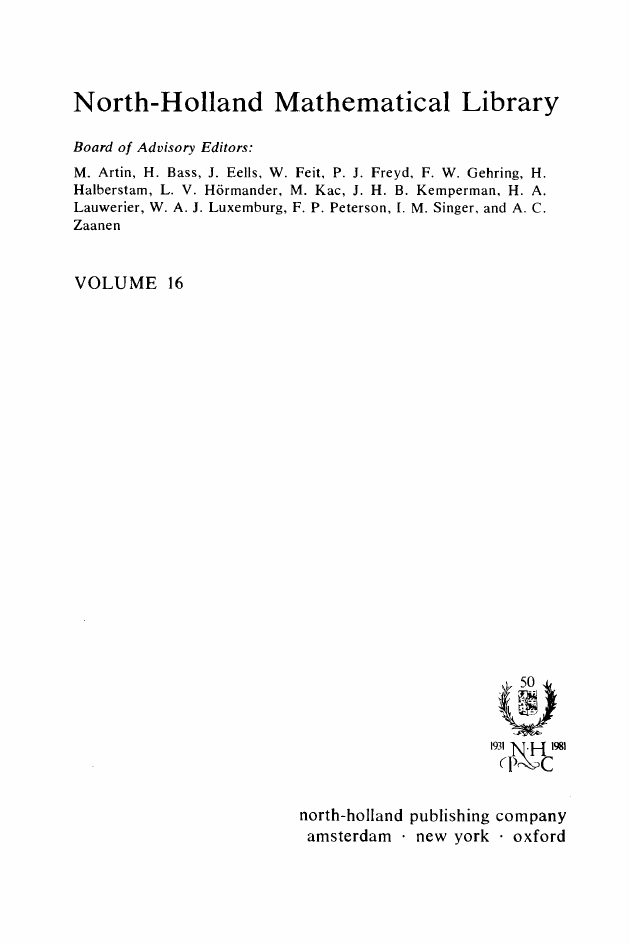
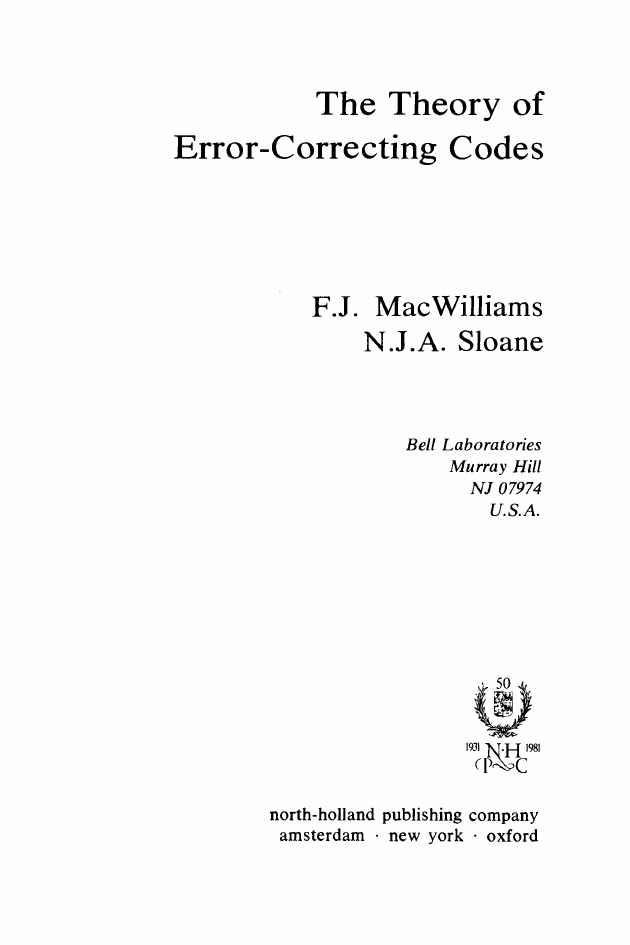
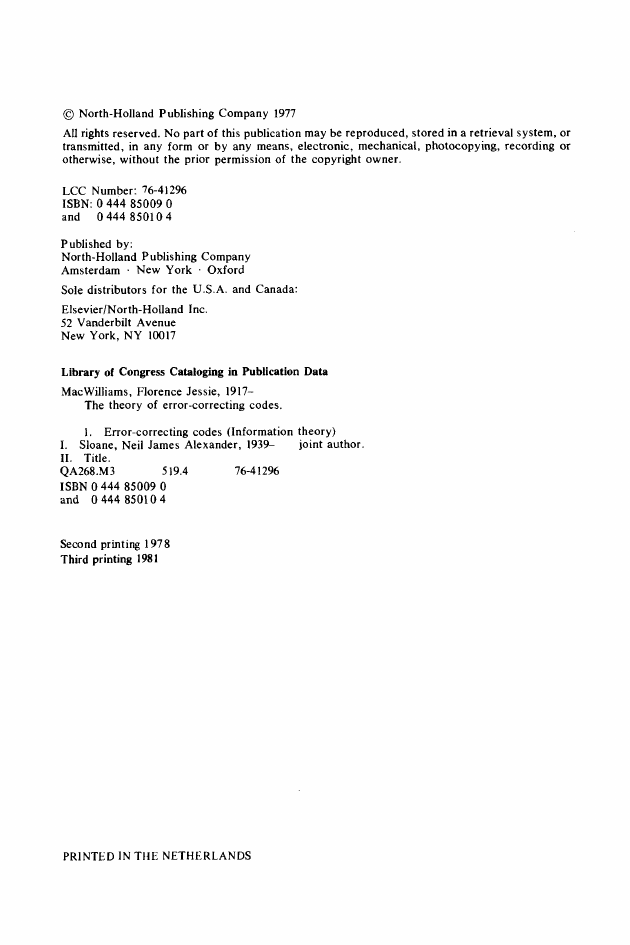
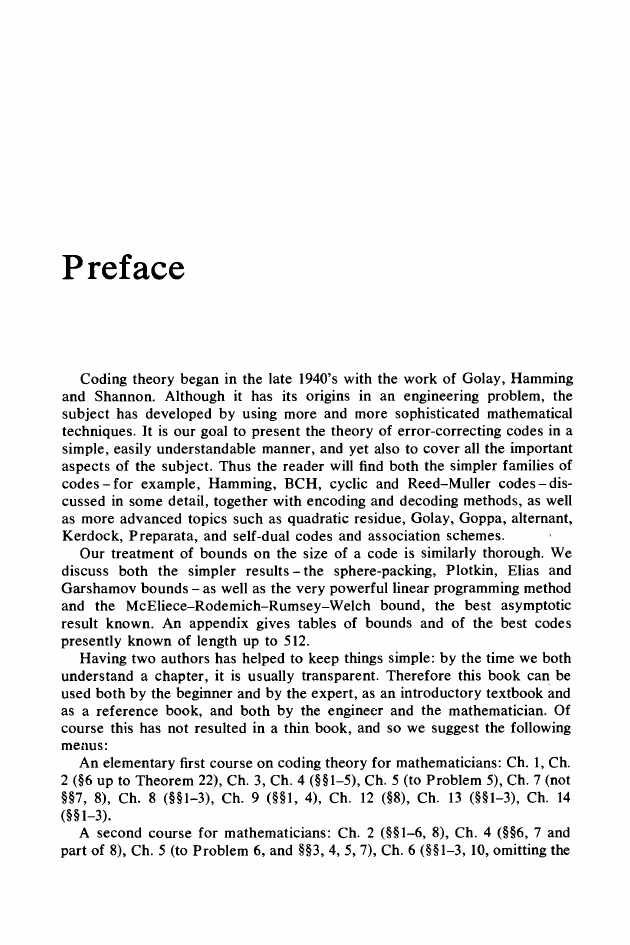

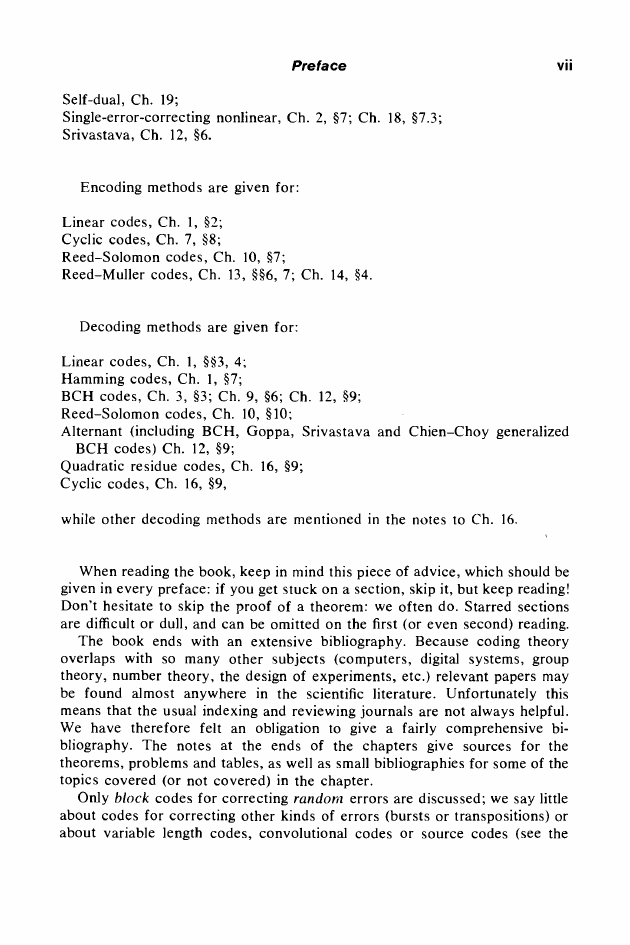
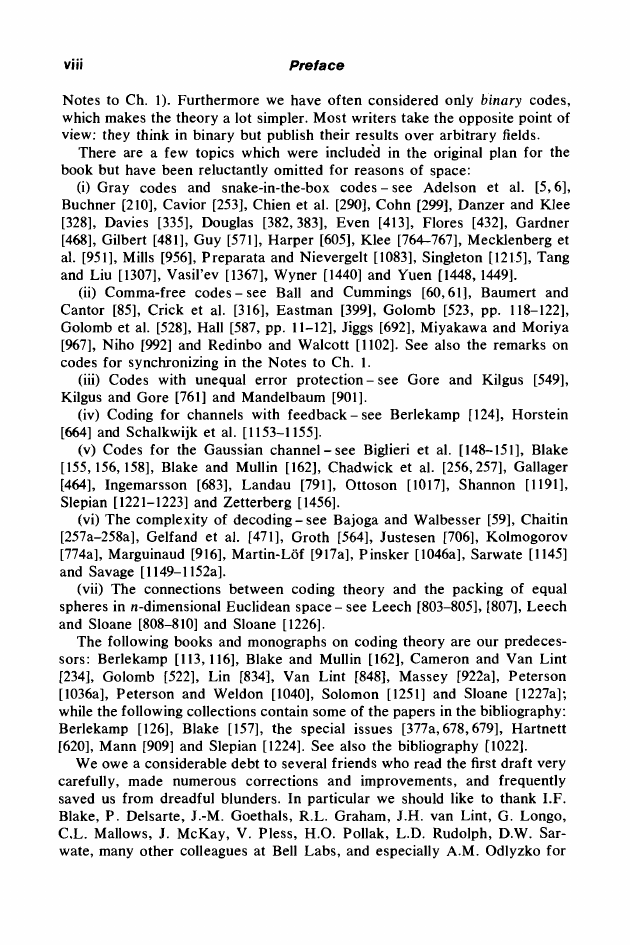
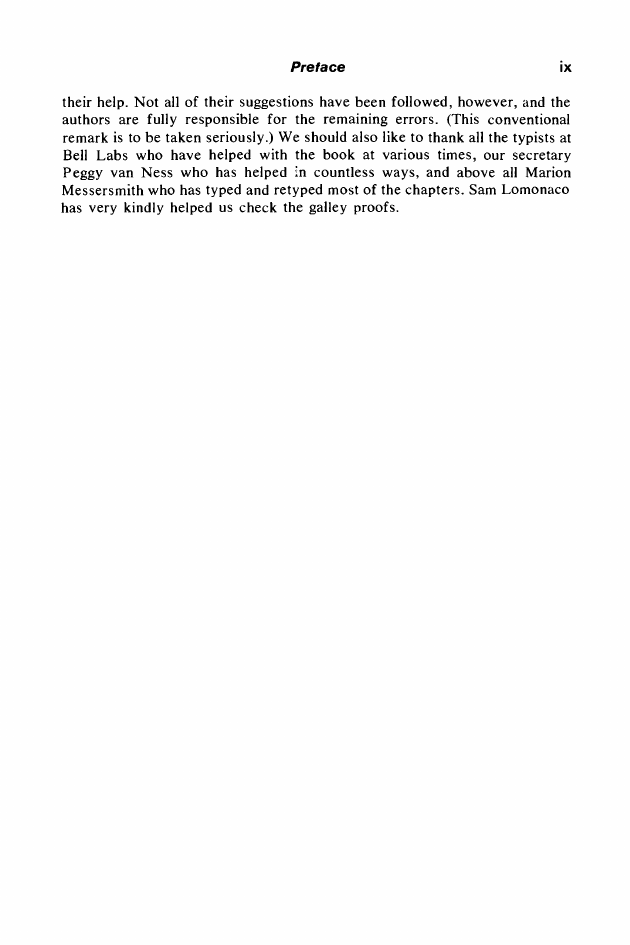








 2023年江西萍乡中考道德与法治真题及答案.doc
2023年江西萍乡中考道德与法治真题及答案.doc 2012年重庆南川中考生物真题及答案.doc
2012年重庆南川中考生物真题及答案.doc 2013年江西师范大学地理学综合及文艺理论基础考研真题.doc
2013年江西师范大学地理学综合及文艺理论基础考研真题.doc 2020年四川甘孜小升初语文真题及答案I卷.doc
2020年四川甘孜小升初语文真题及答案I卷.doc 2020年注册岩土工程师专业基础考试真题及答案.doc
2020年注册岩土工程师专业基础考试真题及答案.doc 2023-2024学年福建省厦门市九年级上学期数学月考试题及答案.doc
2023-2024学年福建省厦门市九年级上学期数学月考试题及答案.doc 2021-2022学年辽宁省沈阳市大东区九年级上学期语文期末试题及答案.doc
2021-2022学年辽宁省沈阳市大东区九年级上学期语文期末试题及答案.doc 2022-2023学年北京东城区初三第一学期物理期末试卷及答案.doc
2022-2023学年北京东城区初三第一学期物理期末试卷及答案.doc 2018上半年江西教师资格初中地理学科知识与教学能力真题及答案.doc
2018上半年江西教师资格初中地理学科知识与教学能力真题及答案.doc 2012年河北国家公务员申论考试真题及答案-省级.doc
2012年河北国家公务员申论考试真题及答案-省级.doc 2020-2021学年江苏省扬州市江都区邵樊片九年级上学期数学第一次质量检测试题及答案.doc
2020-2021学年江苏省扬州市江都区邵樊片九年级上学期数学第一次质量检测试题及答案.doc 2022下半年黑龙江教师资格证中学综合素质真题及答案.doc
2022下半年黑龙江教师资格证中学综合素质真题及答案.doc